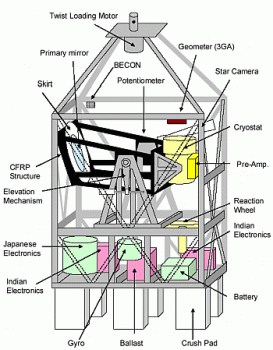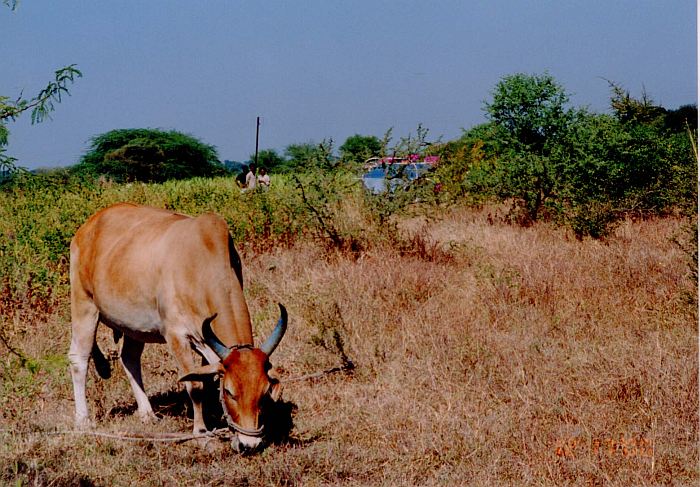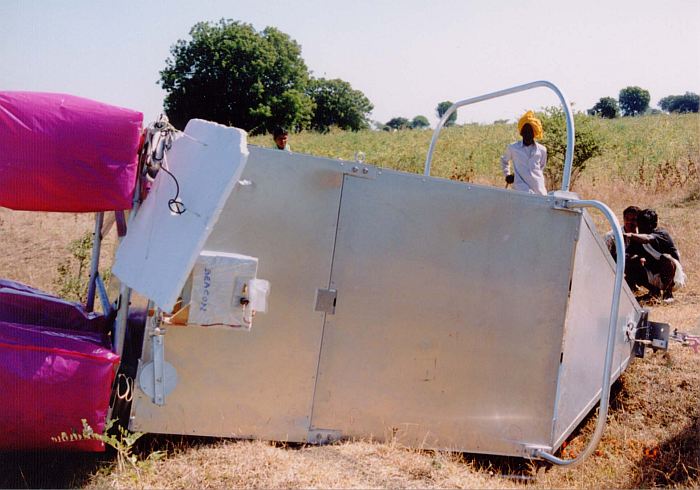Purpose of the flight and payload description
Is an instrument developed for mapping of the far-infrared emission from the Galaxy and external galaxies with the same spatial resolution as that of the IRAS (Infrared Astronomical Satellite) launched on 1983.
It has a telescope with an off-axis parabola glass mirror of 50 cm diameter and a focal length of 1200 mm. The instrument is mounted on the direct focus of this mirror. There is no other un-cooled optics. In order to reduce the instrumental infrared radiation noise from the periphery of the mirror, a ring-shape reflector is attached to the mirror.
Also was developed a far-infrared array camera dedicated for FIRBE. The array has 4 x 8 pixels, and the pixel pitch is 1.5 arcmin. The array uses stressed Ge:Ga photoconductor elements and is installed in a helium cryostat together with a cold reimaging optics.
The gondola on wich the instrument is mounted combines several aluminum pipes and angles, so FIRBE could be lighten the weight of the main frame less than about 100 kg, which also leads to reduce the total weight.
The telescope is deriven by an alt-azimuthal mounting system, the attitude stability is less than 30 arcsec. The attitude during the flight is determined with the data of three-axes fiber-optic gyro assisted by the CCD star camera and derived by a reaction wheel in azimuth and by a drive mechanism of a geared motor in elevation.
Details of the balloon flight

Balloon launched on: 12/16/2000 at 22:55 ist
Launch site: TIFR National Balloon Facility, Hyderabad, India
Balloon launched by: National Balloon Facility, Tata Institute of Fundamental Research
Balloon manufacturer/size/composition: Zero Pressure Balloon Antrix - 239.760 m3
Flight identification number: 448
End of flight (L for landing time, W for last contact, otherwise termination time): 12/17/2000 at 5:30 ist
Balloon flight duration (F: time at float only, otherwise total flight time in d:days / h:hours or m:minutes - ): 6 h 30 m
Landing site: 300 kms from Hyderabad, India
Payload weight: 849 kgs
Overall weight: 1357 kgs
The balloon was launched from Hyderabad at 23:00 on December 16th. 2000 by dynamic method assited by launch vehicle and auxiliary ballons.
After a initial ascent phase a float altitude of 36 km was achieved, 1.5 hour after the launch, controlling the climbing speed with ballast to avoid burst of the balloon.
At the floating altitude, the balloon began to be flown to the northwestern direction with unexpected higher velocity of 50 km per hour.
After a flight of near 6 hours the payload was cut from the balloon at 300 km from the balloon facility at 5:30 AM on December 17th and the payload safety landed on a plain field and was recovered without serious damages.
For this second flight in India the payload was reconstructed after being dismantled by natives.
After the launch and just reaching at the level-flight altitude, was started the azimuth control to stop the azimuth rolling with constant moving the elevation to track Saturn but, some sent command did not were received, which prevented the scientists from controlling the azimuth attitude in real-time.
As the result, it took 1.5 hours to stabilize the azimuth rolling at the direction between the Carina region and the Orion region with over the azimuth difference of over 50º equally. Was neccesary to turn the azimuth direction to the Orion region slowly and started to survey the cross-elevation direction changing the elevation axis to cross the KL nebula frequently.
Approximately, an area of about 50 deg2 was surveyed including the Orion-A and Orion-B (south) within 90 minutes.
After the flight a check revealed that the mechanical axis of the twist loading motor was broken by an unexpected external torque. It was supposed that it was generated by a shock of launching. This is why it took more time to stabilize the azimuth altitude.
External references
- Far-Infrared 160 µm Survey by Balloon-Borne Telescopes Star Formation, Proceedings of Star Formation 1999, held in Nagoya, Japan
- Mechanical properties of ANTRIX balloon film and fabrication of single cap large volume balloons Advances in Space Research 42 (2008) 1691
- New balloon-borne telescope for far-infrared astronomy Proc. SPIE 4014, Airborne Telescope Systems, 237 (June 20, 2000);
- Wide-Area Mapping of 155 Micron Continuum Emission from the Orion Molecular Cloud Complex PASJ, Vol. 56, No. 1
1089If you consider this website interesting or useful, you can help me to keep it up and running with a small donation to cover the operational costs. Just the equivalent of the price of a cup of coffee helps a lot.







